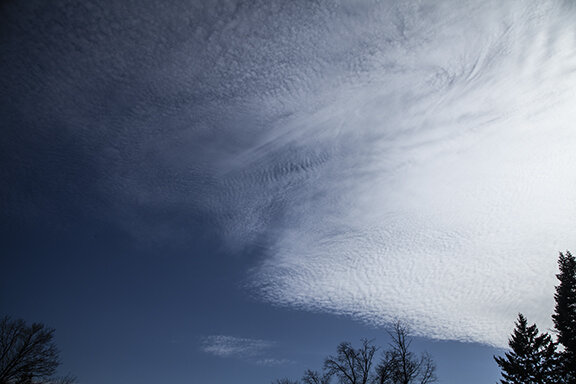Today was a busy weather day. No, there weren’t major storms here. It was just a blustery day, typical for this time of year. But it turns out that it was an interesting study in how our weather works. In this case the weather was very busy behind the scenes.
The Story
Strong winds from an invading polar high pressure, gusty winds, updrafts, downdrafts, and snow showers made for a fun-filled day - if you like that sort of adventure. Between Noon and 8:00 p.m. today increasing air pressure pushed the general wind speeds to about 20 mph. However, air descending to the surface from higher altitudes brought 50 mph gusts to ground level. Solar heating causes the atmosphere to mix with updrafts and downdrafts. These motions created the gusty winds, bringing higher altitude wind speeds to the surface.
When the solar heating waned in the late afternoon all the fun came to a halt. The gusts stopped and general wind speeds decreased. The heating and a storm system aloft had supported the development robust cumulus clouds with snow showers. They dissipated as the sunshine decreased.
The Meteographs
The following meteographs and the photos in the previous post paint an interesting picture. The graphs for temperature, dew point, relative humidity, barometric pressure, wind direction, wind speed, and solar radiation from our weather station tell the story. While the graphs cover the previous 48-hours, the time period of interest is from Noon to 8:00 p.m on the 9th. The tracings show a period of very unsteady changeable weather. It is a great example of how an automatic weather observing station picks up subtle and not so subtle weather changes.
The temperature (red line), dew point (green dotted line), relative humidity (blue dashed line), and air pressure were all unsteady. At the same time, the wind speed increased and became very gusty with snow showers. The solar radiation was very unsteady.
Passing showers with gusty winds caused small changes in air pressure that show up as small bumps in what is a steady pressure increase during the day. Approaching high pressure was responsible for the general all day rise in pressure. Temperature and dew point were very unsteady as the up and down motion of gusty winds were mixing air with different temperature and dew points. The relativity humidity was unsteady because it is directly related to changes in temperature and dew point - which were unsteady. Wind speed and wind gusts increased as stronger winds mixed down to the surface. The solar radiation was changing wildly as clouds covered and uncovered the Sun.
The solar radiation graph is revealing. The overall increase in solar heating is shown very well in the general shape of the graph. Within the general shape there are many large short-term swings in intensity caused by clouds blocking and unblocking the Sun. It was the changes in solar radiation which was behind the changes in the weather. It changed the heating, which changed the air mixing, which changed the wind gusts and development of cumulus clouds and snow showers. As the graphs show, all of the readings smoothed out as the Sun set.














































































































